九大时态详解过去进行时
- 格式:docx
- 大小:11.23 KB
- 文档页数:4
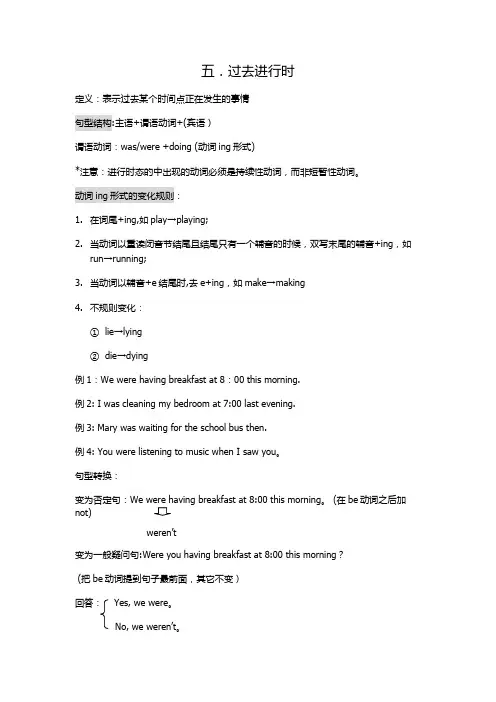
五.过去进行时定义:表示过去某个时间点正在发生的事情句型结构:主语+谓语动词+(宾语)谓语动词:was/were +doing (动词ing形式)*注意:进行时态的中出现的动词必须是持续性动词,而非短暂性动词。
动词ing形式的变化规则:1.在词尾+ing,如play→playing;2.当动词以重读闭音节结尾且结尾只有一个辅音的时候,双写末尾的辅音+ing,如run→running;3.当动词以辅音+e结尾时,去e+ing,如make→making4.不规则变化:①lie→lying②die→dying例1:We were having breakfast at 8:00 this morning.例2: I was cleaning my bedroom at 7:00 last evening.例3: Mary was waiting for the school bus then.例4: You were listening to music when I saw you。
句型转换:变为否定句:We were having breakfast at 8:00 this morning。
(在be动词之后加not)weren’t变为一般疑问句:Were you having breakfast at 8:00 this morning?(把be动词提到句子最前面,其它不变)回答: Yes, we were。
No, we weren’t。
特殊疑问句的变化规则:三步走,一换二代三提前例1:We were having breakfast at 8:00 this morning。
(对划线部分提问) 一换:换成一般疑问句Were you having breakfast at 8:00 this morning?二代:把划线部分用特殊疑问词代入:00 this morning?doing what三提前:把特殊疑问词提前What were you doing at 8:00 this morning?拓展提高:⑴由when引导的时间状语从句,从句用一般过去时,主句用过去进行时when I saw you.引导词注意:当when引导的从句与主句交换位置时,句子意思不变,如You were listening to music when I saw you。
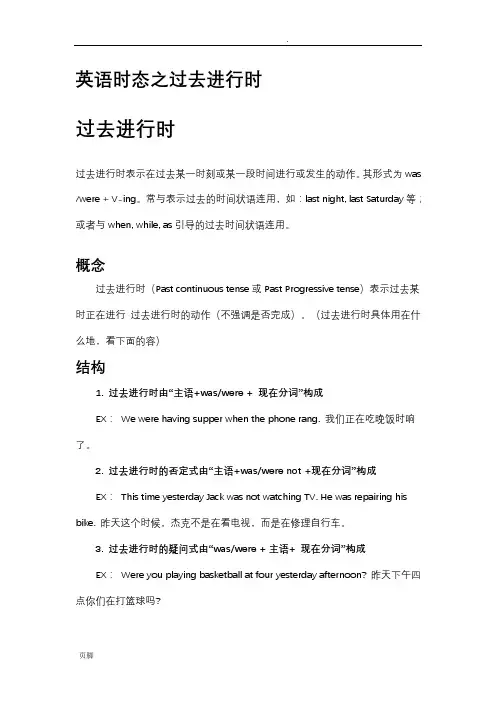
英语时态之过去进行时过去进行时过去进行时表示在过去某一时刻或某一段时间进行或发生的动作。
其形式为was /were + V-ing。
常与表示过去的时间状语连用,如:last night, last Saturday等;或者与when, while, as引导的过去时间状语连用。
概念过去进行时(Past continuous tense或Past Progressive tense)表示过去某时正在进行过去进行时的动作(不强调是否完成)。
(过去进行时具体用在什么地,看下面的容)结构1. 过去进行时由“主语+was/were + 现在分词”构成EX:We were having supper when the phone rang. 我们正在吃晚饭时响了。
2. 过去进行时的否定式由“主语+was/were not +现在分词”构成EX:This time yesterday Jack was not watching TV. He was repairing his bike. 昨天这个时候,杰克不是在看电视,而是在修理自行车。
3. 过去进行时的疑问式由“was/were +主语+ 现在分词”构成EX:Were you playing basketball at four yesterday afternoon? 昨天下午四点你们在打篮球吗?主要用法基本用法1. 过去进行时的基本用法主要表示过去某一时间正在进行的动作。
过去进行时如:He fell asleep when he was reading. 他看书时睡着了。
2. 用过去进行时表示现在主要是为了使语气委婉、客气。
如:I was wondering if you could give me a lift. 我不知你能否让我搭一下车。
【注】一般过去时也有类似用法,但比较而言,用过去进行时显得更客气,更不肯定。
3. 过去进行时表示感情色彩与现在进行时相似,过去进行时也可表示满意、称赞、惊讶、厌恶等感情色彩,也通常与always,forever,continually等副词连用。
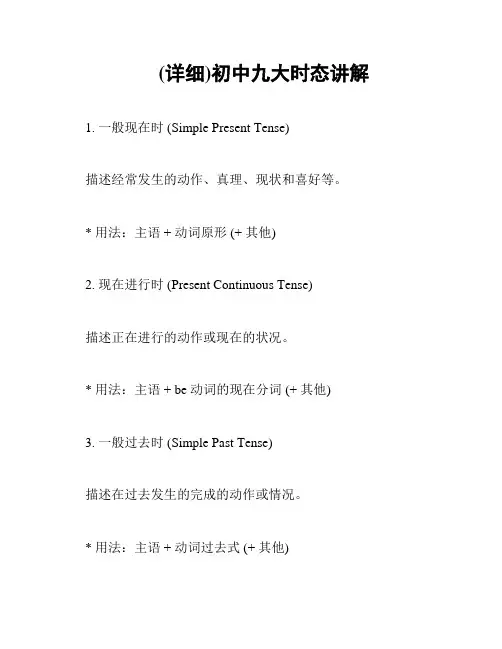
(详细)初中九大时态讲解1. 一般现在时 (Simple Present Tense)描述经常发生的动作、真理、现状和喜好等。
* 用法:主语 + 动词原形 (+ 其他)2. 现在进行时 (Present Continuous Tense)描述正在进行的动作或现在的状况。
* 用法:主语 + be 动词的现在分词 (+ 其他)3. 一般过去时 (Simple Past Tense)描述在过去发生的完成的动作或情况。
* 用法:主语 + 动词过去式 (+ 其他)4. 过去进行时 (Past Continuous Tense)描述在过去某个时间正在进行的动作。
* 用法:主语 + be 动词的过去分词 (+ 其他)5. 一般将来时 (Simple Future Tense)描述将来要发生的动作或情况。
* 用法:主语 + will/shall + 动词原形 (+ 其他)6. 将来进行时 (Future Continuous Tense)描述在某个将来时间正在进行的动作。
* 用法:主语 + will/shall + be + 动词的现在分词 (+ 其他) 7. 现在完成时 (Present Perfect Tense)描述发生在过去但对现在有影响的动作或情况。
* 用法:主语 + have/has + 动词过去分词 (+ 其他)8. 过去完成时 (Past Perfect Tense)描述在过去某个时间或发生的动作或情况。
* 用法:主语 + had + 动词过去分词 (+ 其他)9. 将来完成时 (Future Perfect Tense)描述在某个将来时间之前将要完成的动作或情况。
* 用法:主语 + will/shall + have + 动词过去分词 (+ 其他)在研究和掌握这九大时态时,可以通过大量的练和实践来加深理解和记忆。
希望本文档对您有所帮助!参考资料:。
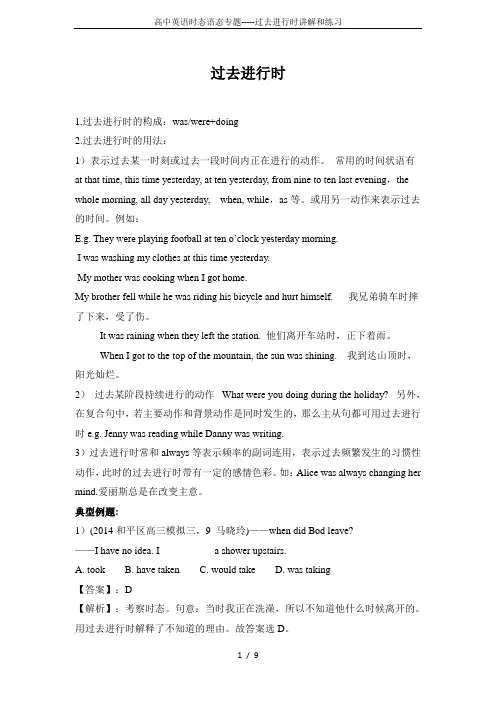
过去进行时1.过去进行时的构成:was/were+doing2.过去进行时的用法:1)表示过去某一时刻或过去一段时间内正在进行的动作。
常用的时间状语有at that time, this time yesterday, at ten yesterday, from nine to ten last evening,the whole morning, all day yesterday, when, while,as等。
或用另一动作来表示过去的时间。
例如:E.g. They were playing football at ten o’clock yesterday morning.I was washing my clothes at this time yesterday.My mother was cooking when I got home.My brother fell while he was riding his bicycle and hurt himself.我兄弟骑车时摔了下来,受了伤。
It was raining when they left the station. 他们离开车站时,正下着雨。
When I got to the top of the mountain, the sun was shining.我到达山顶时,阳光灿烂。
2)过去某阶段持续进行的动作What were you doing during the holiday? 另外,在复合句中,若主要动作和背景动作是同时发生的,那么主从句都可用过去进行时e.g. Jenny was reading while Danny was writing.3)过去进行时常和always等表示频率的副词连用,表示过去频繁发生的习惯性动作,此时的过去进行时带有一定的感情色彩。
如:Alice was always changing her mind.爱丽斯总是在改变主意。
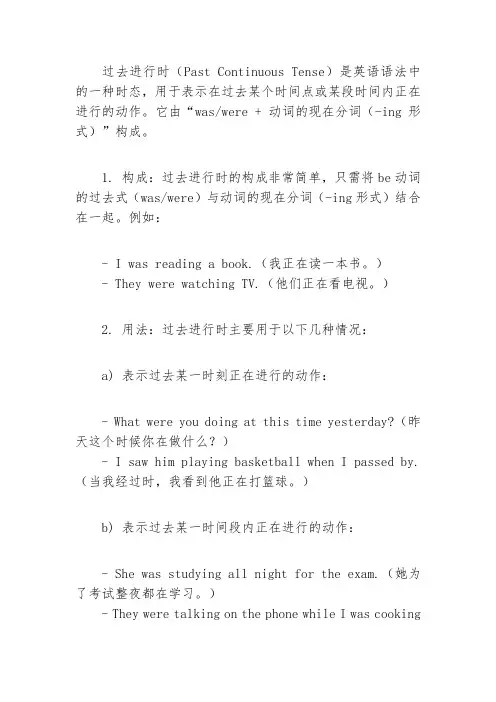
过去进行时(Past Continuous Tense)是英语语法中的一种时态,用于表示在过去某个时间点或某段时间内正在进行的动作。
它由“was/were + 动词的现在分词(-ing形式)”构成。
1. 构成:过去进行时的构成非常简单,只需将be动词的过去式(was/were)与动词的现在分词(-ing形式)结合在一起。
例如:- I was reading a book.(我正在读一本书。
)- They were watching TV.(他们正在看电视。
)2. 用法:过去进行时主要用于以下几种情况:a) 表示过去某一时刻正在进行的动作:- What were you doing at this time yesterday?(昨天这个时候你在做什么?)- I saw him playing basketball when I passed by.(当我经过时,我看到他正在打篮球。
)b) 表示过去某一时间段内正在进行的动作:- She was studying all night for the exam.(她为了考试整夜都在学习。
)- They were talking on the phone while I was cookingdinner.(我在做晚饭的时候,他们在打电话。
)c) 表示过去某一动作发生的背景或同时发生的另一个动作:- He was listening to music while he was working.(他在工作时听音乐。
)- She was reading a magazine when the phone rang.(电话响的时候,她正在看杂志。
)3. 注意事项:a) 当表示过去某一时刻正在进行的动作时,通常与表示过去的时间状语连用,如yesterday, last night, in 1990等。
b) 当表示过去某一时间段内正在进行的动作时,通常与表示过去的时间状语连用,如from 7 to 9 last night, all day yesterday等。

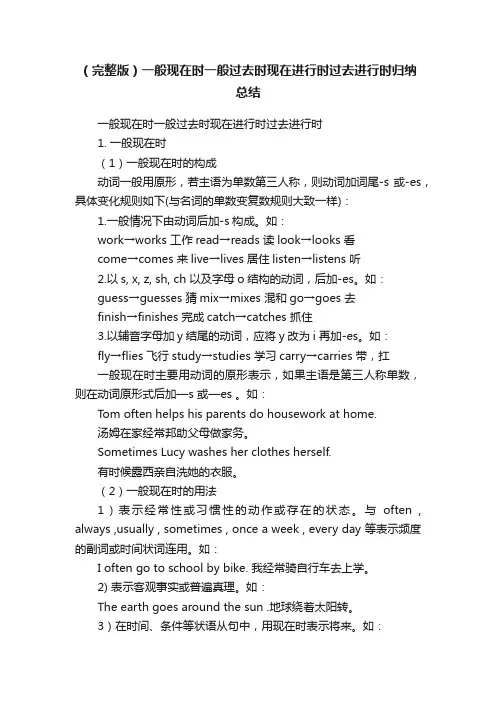
(完整版)一般现在时一般过去时现在进行时过去进行时归纳总结一般现在时一般过去时现在进行时过去进行时1. 一般现在时(1)一般现在时的构成动词一般用原形,若主语为单数第三人称,则动词加词尾-s或-es,具体变化规则如下(与名词的单数变复数规则大致一样):1.一般情况下由动词后加-s构成。
如:work→works 工作read→reads 读look→looks 看come→comes 来live→lives 居住listen→listens 听2.以s, x, z, sh, ch 以及字母o结构的动词,后加-es。
如:guess→guesses 猜mix→mixes 混和go→goes 去finish→finishes 完成catch→catches 抓住3.以辅音字母加y结尾的动词,应将y改为i 再加-es。
如:fly→flies 飞行study→studies 学习carry→carries 带,扛一般现在时主要用动词的原形表示,如果主语是第三人称单数,则在动词原形式后加—s 或—es 。
如:Tom often helps his parents do housework at home.汤姆在家经常邦助父母做家务。
Sometimes Lucy washes her clothes herself.有时候露西亲自洗她的衣服。
(2)一般现在时的用法1)表示经常性或习惯性的动作或存在的状态。
与often , always ,usually , sometimes , once a week , every day 等表示频度的副词或时间状词连用。
如:I often go to school by bike. 我经常骑自行车去上学。
2) 表示客观事实或普遍真理。
如:The earth goes around the sun .地球绕着太阳转。
3)在时间、条件等状语从句中,用现在时表示将来。
如:If it rains tomorrow, we won’t go to the park.如果明天下雨,我们就不去公园了。
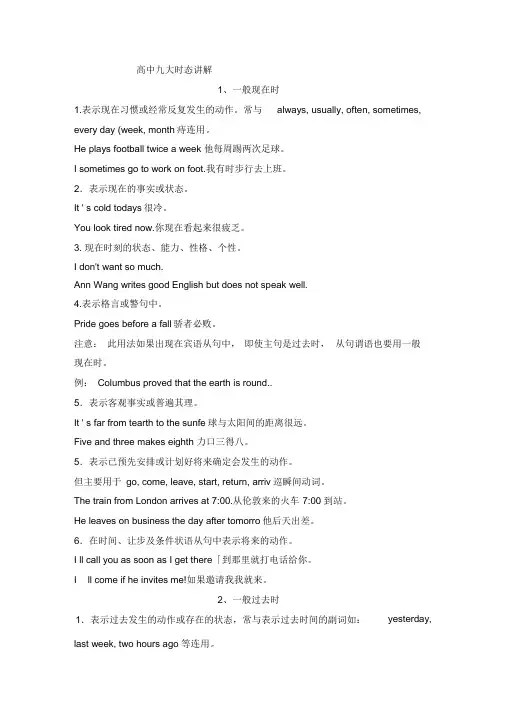
高中九大时态讲解1、一般现在时1.表示现在习惯或经常反复发生的动作。
常与always, usually, often, sometimes, every day (week, month痔连用。
He plays football twice a week 他每周踢两次足球。
I sometimes go to work on foot.我有时步行去上班。
2.表示现在的事实或状态。
It ' s cold todays很冷。
You look tired now.你现在看起来很疲乏。
3. 现在时刻的状态、能力、性格、个性。
I don't want so much.Ann Wang writes good English but does not speak well.4.表示格言或警句中。
Pride goes before a fall骄者必败。
注意:此用法如果出现在宾语从句中,即使主句是过去时,从句谓语也要用一般现在时。
例:Columbus proved that the earth is round..5.表示客观事实或普遍其理。
It ' s far from tearth to the sunfe球与太阳间的距离很远。
Five and three makes eighth 力口三得八。
5.表示已预先安排或计划好将来确定会发生的动作。
但主要用于go, come, leave, start, return, arriv巡瞬间动词。
The train from London arrives at 7:00.从伦敦来的火车7:00 到站。
He leaves on business the day after tomorro他后天出差。
6.在时间、让步及条件状语从句中表示将来的动作。
I ll call you as soon as I get there「到那里就打电话给你。
I ll come if he invites me!如果邀请我我就来。
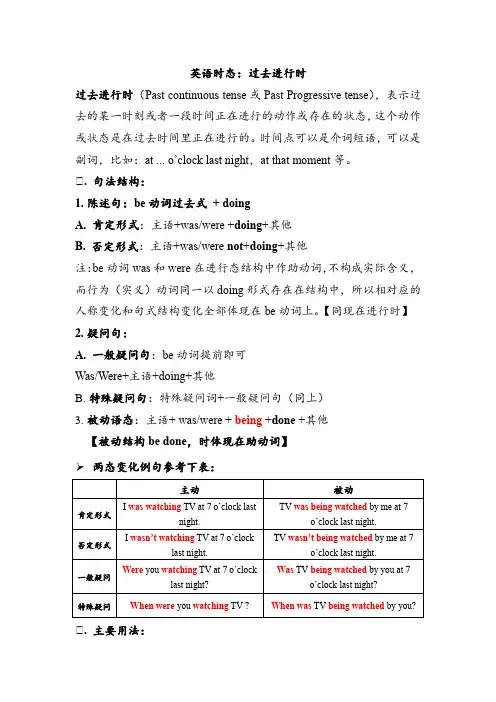
英语时态:过去进行时过去进行时(Past continuous tense或Past Progressive tense),表示过去的某一时刻或者一段时间正在进行的动作或存在的状态,这个动作或状态是在过去时间里正在进行的。
时间点可以是介词短语,可以是副词,比如:at ... o’clock last night,at that moment等。
Ⅰ. 句法结构:1.陈述句:be动词过去式+ doingA. 肯定形式:主语+was/were +doing+其他B. 否定形式:主语+was/were not+doing+其他注:be动词was和were在进行态结构中作助动词,不构成实际含义,而行为(实义)动词同一以doing形式存在在结构中,所以相对应的人称变化和句式结构变化全部体现在be动词上。
【同现在进行时】2.疑问句:A. 一般疑问句:be动词提前即可Was/Were+主语+doing+其他B.特殊疑问句:特殊疑问词+一般疑问句(同上)3.被动语态:主语+ was/were + being +done +其他【被动结构be done,时体现在助动词】➢两态变化例句参考下表:Ⅰ. 主要用法:1.(基本用法)过去进行时主要表示过去某一时间正在进行的动作。
He fell asleep when he was reading.2.用于描写故事情景,或提供故事发生的时间背景。
The fire was burning. Children were crying. Women were running about and men were trying to put it out.3.用过去进行时表示现在,主要是为了使语气委婉、客气。
此类动词主要有hope, wonder, think, expect等。
【一般过去时也有类似用法,但比较而言,用过去进行时显得更客气,更加不肯定。
】I was wondering if you can give me a hand.4.表示从过去某一时间看将要发生的动作,常表示过去“渐渐”、“快要”、“越来越”、“马上”等含义,常见的此类动词有come,go,start,begin,leave,arrive,get,become,turn等非持续性(位置的瞬间移动或状态的瞬间改变)动词,偶尔有些持续性动词如do,stay,take 等常表示过去“将要”。
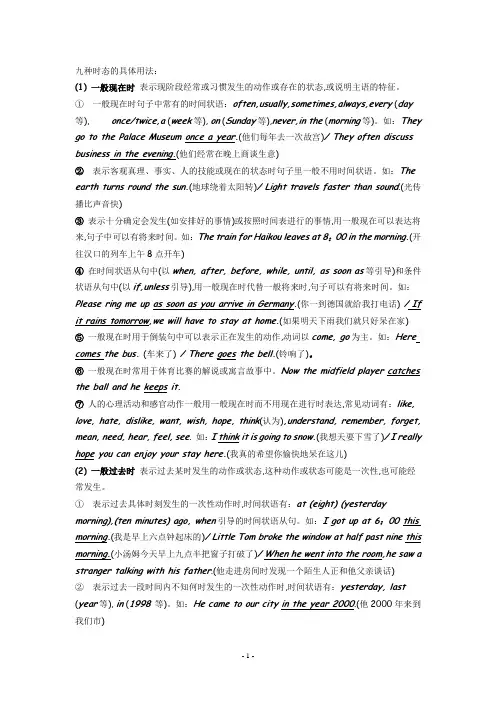
九种时态的具体用法:(1) 一般现在时表示现阶段经常或习惯发生的动作或存在的状态,或说明主语的特征。
①一般现在时句子中常有的时间状语:often,usually,sometimes,always,every (day等), once/twice,a (week等), on (Sunday等),never,in the (morning等)。
如:They go to the Palace Museum once a year.(他们每年去一次故宫)/ They often discuss business in the evening.(他们经常在晚上商谈生意)②表示客观真理、事实、人的技能或现在的状态时句子里一般不用时间状语。
如:The earth turns round the sun.(地球绕着太阳转)/ Light travels faster than sound.(光传播比声音快)③表示十分确定会发生(如安排好的事情)或按照时间表进行的事情,用一般现在可以表达将来,句子中可以有将来时间。
如:The train for Haikou leaves at 8:00 in the morning.(开往汉口的列车上午8点开车)④在时间状语从句中(以when, after, before, while, until, as soon as等引导)和条件状语从句中(以if,unless引导),用一般现在时代替一般将来时,句子可以有将来时间。
如:Please ring me up as soon as you arrive in Germany.(你一到德国就给我打电话) / If it rains tomorrow,we will have to stay at home.(如果明天下雨我们就只好呆在家)⑤一般现在时用于倒装句中可以表示正在发生的动作,动词以come, go为主。
如:Here comes the bus. (车来了) / There goes the bell.(铃响了)。
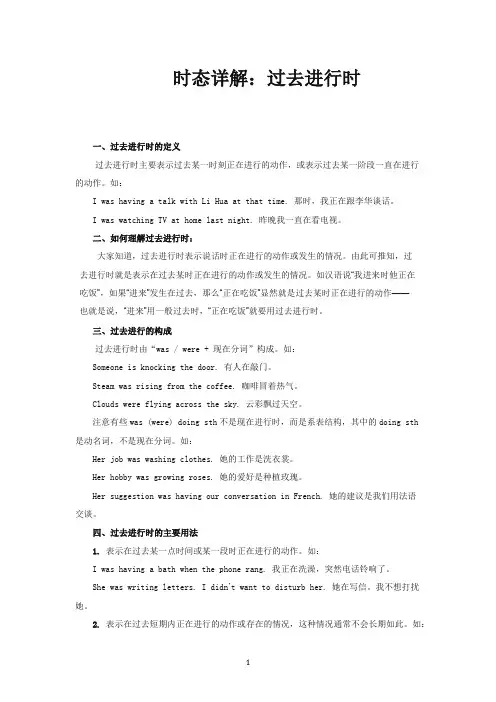
时态详解:过去进行时一、过去进行时的定义过去进行时主要表示过去某一时刻正在进行的动作,或表示过去某一阶段一直在进行的动作。
如:I was having a talk with Li Hua at that time. 那时,我正在跟李华谈话。
I was watching TV at home last night. 昨晚我一直在看电视。
二、如何理解过去进行时:大家知道,过去进行时表示说话时正在进行的动作或发生的情况。
由此可推知,过去进行时就是表示在过去某时正在进行的动作或发生的情况。
如汉语说“我进来时他正在吃饭”,如果“进来”发生在过去,那么“正在吃饭”显然就是过去某时正在进行的动作——也就是说,“进来”用一般过去时,“正在吃饭”就要用过去进行时。
三、过去进行的构成过去进行时由“was / were + 现在分词”构成。
如:Someone is knocking the door. 有人在敲门。
Steam was rising from the coffee. 咖啡冒着热气。
Clouds were flying across the sky. 云彩飘过天空。
注意有些was (were) doing sth不是现在进行时,而是系表结构,其中的doing sth是动名词,不是现在分词。
如:Her job was washing clothes. 她的工作是洗衣裳。
Her hobby was growing roses. 她的爱好是种植玫瑰。
Her suggestion was having our conversation in French. 她的建议是我们用法语交谈。
四、过去进行时的主要用法1. 表示在过去某一点时间或某一段时正在进行的动作。
如:I was having a bath when the phone rang. 我正在洗澡,突然电话铃响了。
She was writing letters. I didn’t want to disturb her. 她在写信。
过去进行时知识点归纳与总结过去进行时是英语中的一种时态,用来表示过去某一时刻或某一段时间正在进行的动作或情况。
在这篇文章中,我们将对过去进行时的用法进行归纳与总结。
一、过去进行时的构成过去进行时由助动词“was/were”和动词的现在分词形式构成。
例如:I was studying all night.(我昨晚一直在学习。
)They were playing soccer when it started raining.(天开始下雨时,他们正在踢足球。
)二、过去进行时的用法1. 表示过去某一时刻的持续动作或情况过去进行时常用来表示过去某一时刻正在进行的动作或情况。
例如:I was cooking dinner at 7 o'clock last night.(昨晚7点钟的时候我正在煮晚餐。
)She was reading a book when her brother came home.(她的弟弟回家时,她正在读书。
)2. 表示过去某一段时间的持续动作或情况过去进行时也可以用来表示过去某一段时间内持续进行的动作或情况。
例如:They were living in London for three years.(他们在伦敦住了三年。
)I was working on this project all day yesterday.(我昨天一整天都在做这个项目。
)3. 表示过去某一时刻的计划或安排过去进行时还可以用来表示过去某一时刻的计划或安排。
例如:We were supposed to go to the movies, but it started raining.(我们原本计划去看电影,但天开始下雨了。
)She was going to meet her friends, but she got sick.(她原本打算去见朋友,但她生病了。
)4. 与时间状语连用过去进行时通常与表示过去的时间状语连用,以强调动作或情况的持续性。
英语九大时态总结表格时态概述英语中共有九种时态,它们分别是:一般现在时、一般过去时、一般将来时、现在进行时、过去进行时、将来进行时、现在完成时、过去完成时和将来完成时。
这些时态的正确使用对于表达正确的时间和语义非常重要。
以下是对每种时态的简要总结。
时态使用场景例句一般现在时表示经常性或普遍真理I go to school every day.一般过去时表示过去发生的事情She watched a movie last night.一般将来时表示将来发生的事情They will travel to France next week.现在进行时表示现在进行的动作I am studying for my exams.过去进行时表示过去某个时间段内进行的动作He was working late yesterday.将来进行时表示将来某个时间段内进行的动作They will be having dinner at 8 PMtomorrow.现在完成时表示过去的动作对现在造成的影响She has already eaten lunch.过去完成时表示过去的动作对过去的另一个动作造成的影响I had already finished my homeworkwhen she called.将来完成时表示将来某个时间点之前已经完成的动作By this time next month, I will havegraduated.时态详解一般现在时一般现在时用于表示经常性的动作、习惯、事实或普遍的真理。
它使用动词的原形(不带s、es等变化)。
例如:•I go to school every day.•He speaks English fluently.•Dogs bark.一般过去时一般过去时用于表示过去发生的事情或状态。
它使用动词的过去式形式。
例如:•She watched a movie last night.•They lived in that house for five years.•I didn’t see him yesterday.一般将来时一般将来时用于表示将来要发生的事情。
初中英语9大时态+3大从句+70个核心句型一、一般现在时表示经常发生的动作或经常存在的状态。
常和always , often , usually , sometimes , every day等表时间的状语连用。
如:1) I go to school every day . 我每天都去学校。
(表经常)2) He is always like that . 他总是那样。
(表状态)构成:1) 主语+ be (am / are / is ) +……2) 主语+ 实义动词+ …二、一般过去时1) 表示过去某个时间发生的动作或存在的状态。
常和表示过去的时间状语连用。
如:yesterday , last week , in 1998 , two days ago等。
如:I went to a movie yesterday. 我昨天去看了一场电影。
2) 也可表示过去经常或反复发生的动作。
如: He always went to work by bike last week.构成:1) 主语+ be (was / were ) +……2) 主语+ 实义动词过去式+…三、现在进行时表示现在(说话瞬间)正在进行或发生的动作。
如:He is singing.They are watching TV now.构成:主语+ 助动词be(am/are/is) + 动词-ing形式构成四、过去进行时表示过去某一时刻或某一段时间正在进行的动作。
这一特定的过去时间除了有上下文暗示外,一般用时间状语来表示。
如:1) ---What were you doing?---I was jumping.2) ---What was the boy doing when the UFO arrived?---He was sleeping.构成:主语+ 助动词be(was/were) + 动词-ing形式构成.五、一般将来时表示将来某个时间要发生的动作或存在的状态,也表示将来经常或反复发生的动作。
九种时态的具体用法:(1)一般现在时表示现阶段经常或习惯发生的动作或存在的状态,或说明主语的特征。
①一般现在时句子中常有的时间状语:often ,usually, sometimes, always, every(day等), once/ twice ,a (week等), on(Sunday等),never ,in the(morning等)。
如:They go to the Palace Museum once a year.(他们每年去一次故宫)/ Theyoften discuss business in the evening.(他们经常在晚上商谈生意)②表示客观真理、事实、人的技能或现在的状态时句子里一般不用时间状语。
如:The earth turns round the sun.(地球绕着太阳转)/ Light travels faster thansound.(光传播比声音快)③表示十分确定会发生(如安排好的事情)或按照时间表进行的事情,用一般现在可以表达将来,句子中可以有将来时间。
如:The train for Haikou leaves at 8:00 inthe morning.(开往汉口的列车上午8点开车)④在时间状语从句中(以when, after, before, while, until, as soon as等引导)和条件状语从句中(以if,unless引导),用一般现在时代替一般将来时,句子可以有将来时间。
如:Please ring me up as soon as you arrive in Germany.(你一到德国就给我打电话) / If it rains tomorrow,we will have to stay at home.(如果明天下雨我们就只好呆在家)⑤一般现在时用于倒装句中可以表示正在发生的动作,动词以come, go为主。
如:Here comes the bus. (车来了) / There goes the bell.(铃响了)。
1.过去进行时的定义过去进行时是表示过去某一时刻或某一时间内正在进行或发生的动作。
可以从两个方面来理解:1) 过去某一时刻正在进行或发生的动作。
E.g. They were playing football at ten o’clockyesterday morning. My mother was cooking when I got home.I was washing my clothes at this time yesterday.I was having a talk with Li Hua at that time. 那时,我正在跟李华谈话。
2) 过去某阶段持续进行的动作What were you doing during the holiday? 另外,在复合句中,若主要动作和背景动作是同时发生的,那么主从句都可用过去进行时e.g. Jenny was readingwhile Danny was writing.I was watching TV at home last night. 昨晚我一直在看电视。
2. 过去进行时的结构及句型变化过去进行时由“was / were + 现在分词”构成。
如:I was doing my lessons then. 那时,我在做功课。
We were cleaning the house. 我们在打扫房子。
过去将来时态的肯定句、否定句和疑问句形式:肯定句例句:I was walking down the street when a UFO landed.否定句例句:I wasn't walking down the street when a UFO landed.一般疑问句例句:Were you walking down the street when a UFO landed?特殊疑问句例句:What were you doing when a UFO landed?3过去进行时的用法详解(1)表示在过去某一时间正在进行的动作,此时句中往往有表示过去的时间状语then,at that time, this time, yesterday等。
时态详解:过去进行时一、过去进行时的定义过去进行时主要表示过去某一时刻正在进行的动作,或表示过去某一阶段一直在进行的动作。
如:I was having a talk with Li Hua at that time. 那时,我正在跟李华谈话。
I was watching TV at home last night. 昨晚我一直在看电视。
I was having a bath when the phone rang. 我正在洗澡,突然电话铃响了。
While I was working in the garden, my wife was cooking dinner. 我在园子里干活时,我妻子正在做饭。
二、如何理解过去进行时:大家知道,过去进行时表示说话时正在进行的动作或发生的情况。
由此可推知,过去进行时就是表示在过去某时正在进行的动作或发生的情况。
如汉语说“我进来时他正在吃饭”,如果“进来”发生在过去,那么“正在吃饭”显然就是过去某时正在进行的动作——也就是说,“进来”用一般过去时,“正在吃饭”就要用过去进行时。
三、过去进行的构成现在进行时由“am / is /are+现在分词”构成。
如果我们将现在进行时中的助动词am / is / are 改为过去式was / were,那么现在进行时就变成了过去进行时,也就是说过去进行时由“was / were + 现在分词”构成。
过去进行时由“was / were + 现在分词”构成。
如:He fell asleep when he was reading. 他看书时睡着了。
We were expecting you yesterday. 我们昨天一直在等你。
Someone is knocking the door. 有人在敲门。
Steam was rising from the coffee. 咖啡冒着热气。
Clouds were flying across the sky. 云彩飘过天空。
五.过去进行时定义:表示过去某个时间点正在发生的事情
句型结构:主语+谓语动词+(宾语)
谓语动词:was/were +doing (动词ing形式)
*注意:进行时态的中出现的动词必须是持续性动词,而非短暂性动词。
动词ing形式的变化规则:
1.在词尾+ing,如play→playing;
2.当动词以重读闭音节结尾且结尾只有一个辅音的时候,双写末尾的辅音+ing,如run
→running;
3.当动词以辅音+e结尾时,去e+ing,如make→making
4.不规则变化:
①lie→lying
②die→dying
例1:We were having breakfast at 8:00 this morning.
例2: I was cleaning my bedroom at 7:00 last evening.
例3: Mary was waiting for the school bus then.
例4: You were listening to music when I saw you.
句型转换:
变为否定句:We were having breakfast at 8:00 this morning. (在be动词之后加
not)
weren’t
变为一般疑问句:Were you having breakfast at 8:00 this morning?
(把be动词提到句子最前面,其它不变)
回答: Yes, we were.
No, we weren’t.
特殊疑问句的变化规则:三步走,一换二代三提前
例1:We were having breakfast at 8:00 this morning.(对划线部分提问)
一换:换成一般疑问句
Were you having breakfast at 8:00 this morning?
二代:把划线部分用特殊疑问词代入
doing what
三提前:把特殊疑问词提前
What were you doing at 8:00 this morning?
拓展提高:
⑴由when引导的时间状语从句,从句用一般过去时,主句用过去进行时
主句:过去进行时引导词从句:一般过去时
注意:当when引导的从句与主句交换位置时,句子意思不变,如
You were listening to music when I saw you.
=When I saw you, you were listening to music.
She was reading a book when her mother came back home.
=When her mother came back home, she was reading a book.
⑵由while引导的时间状语从句,主句和从句都用过去进行时
主句:过去进行时引导词从句:过去进行时
=While my dad was watching TV, I was doing my homework.
Linda was cleaning her bedroom while her brother was playing outside.
=While her brother was playing outside, Linda was cleaning her bedroom.
注意:从句要紧跟着引导词。
练习一:请写出例 2、3、4的否定句,一般疑问句及其问答。
练习二:请把下列句子改成特殊疑问句(写出变化步骤)
1.The students were watching TV at home last night.
①②③
练习三:用适当的引导词,把下列句子连成一句话
1. A. Martin was watering the flowers. B. Linda came in.
2. A. Cindy and Lucy were studying English. B. The telephone rang.
3.I was cooking the meal. B. My younger brother was playing football.。